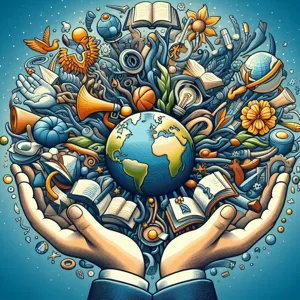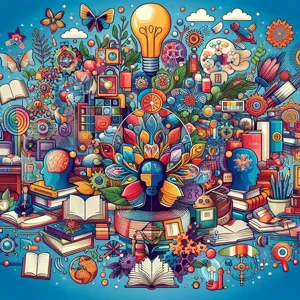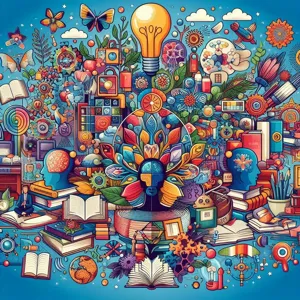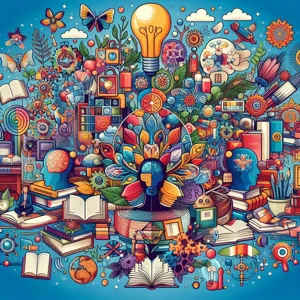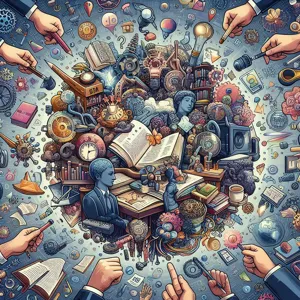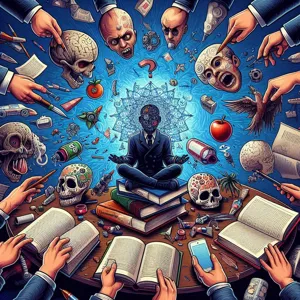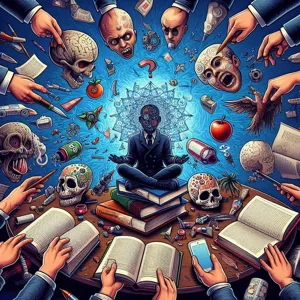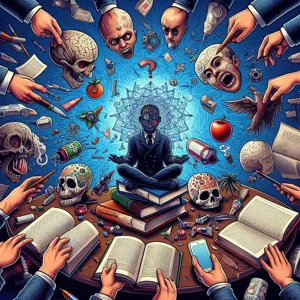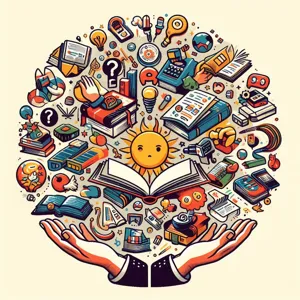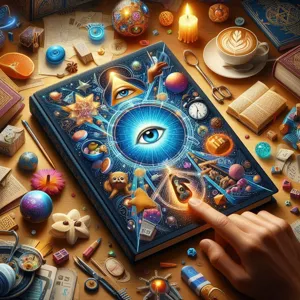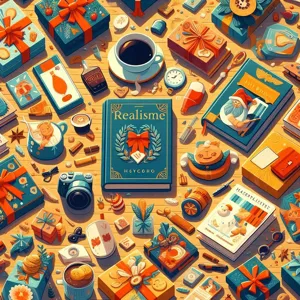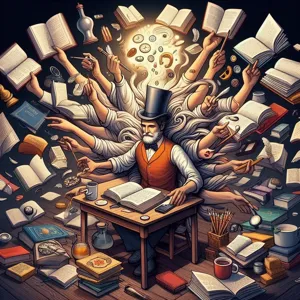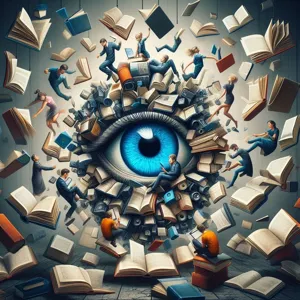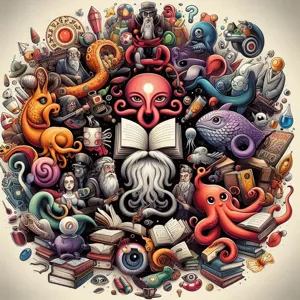In a world brimming with the mundane and the routine, there exists a profound power in the pages of a book—the ability to whisk you away from your everyday life and immerse you in realms of wonder and imagination.
Whether it’s soaring through the skies on the back of a dragon, traversing enchanted forests, or delving into futuristic societies, literature offers a ticket to extraordinary adventures and experiences. In this blog post, we invite you on a journey through ten remarkable books that promise to transport you to another world, each crafted with rich narratives and vivid characters that will spark your imagination and inspire your dreams. Prepare to set aside your worries, as we delve into tales that transcend time and space, inviting you to lose yourself in the magic of storytelling. Get ready to explore the uncharted territories of your mind and heart, and discover the transformative power of these literary gems.
1. Introduction: The Power of Escapism in Literature
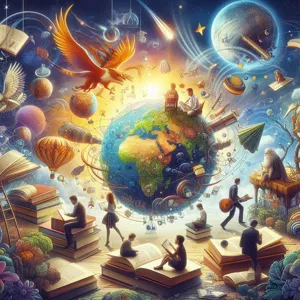
In a world that often feels overwhelming and chaotic, the allure of escapism through literature provides a much-needed refuge for our minds and souls. Books possess an extraordinary power to transport us to realms beyond our own, allowing us to step into the shoes of characters in far-flung places, experience adventures that defy the laws of nature, and encounter emotions that resonate deeply within us. This transformative experience is not merely a distraction; it’s a gateway to understanding diverse perspectives and exploring the vast landscapes of human imagination.
Literature has the unique ability to whisk us away from our everyday lives, immersing us in narratives that ignite our creativity and spark our curiosity. Whether it’s the whimsical wonders of a fantastical kingdom, the gripping suspense of a dystopian future, or the rich tapestry of a historical saga, each story offers an escape into a world where anything is possible. As we turn the pages, we are invited to leave behind our worries and embark on adventures that challenge our perceptions and expand our horizons.
In this post, we’ll delve into ten exceptional books that excel in crafting immersive experiences. These literary gems promise to whisk you away on incredible journeys, inviting you to lose yourself in their pages and rediscover the magic of imagination. Prepare to set aside your daily routine and embark on a voyage through captivating worlds, as we explore the transformative power of escapism in literature. Whether you seek solace, excitement, or enlightenment, these books are sure to transport you to a place where the extraordinary becomes the norm, and where every turn of the page reveals a new facet of wonder.
2. Criteria for Choosing the Right Books
When embarking on a literary journey that whisks you away to fantastical realms, selecting the right books is crucial. With thousands of titles available, how do you pinpoint the ones that will truly transport you? Here are some essential criteria to consider as you curate your reading list.
**Genre Exploration:** First, consider the genre that resonates most with you. Fantasy and science fiction often lead the charge in transporting readers to other worlds, but don’t overlook the power of magical realism, historical fiction, or even well-crafted thrillers that introduce you to unfamiliar settings. Each genre has its own unique style of world-building, so think about what captivates your imagination the most.
**Author’s Craft:** The writing style of an author can significantly impact your reading experience. Look for books by authors known for their vivid descriptions and immersive storytelling. A well-crafted narrative will pull you into the world, allowing you to visualize every detail and feel every emotion. Books that employ rich imagery, compelling dialogue, and unique perspectives can enhance your journey and make the experience more memorable.
**World-Building Depth:** Pay attention to how authors construct their worlds. A fully realized universe, complete with its own rules, cultures, and histories, can make you feel as though you’ve stepped into an entirely new reality. Look for novels that offer intricate world-building, where the setting is almost a character in its own right. This depth allows readers to lose themselves in the intricacies of a world that feels both real and fantastical.
**Character Development:** Characters are your guides through these new worlds, so consider how well-developed they are. Relatable and dynamic characters can enhance the emotional stakes of the story, making the journey more engaging. When you connect with the characters, their adventures will feel more personal, pulling you deeper into their world and experiences.
**Recommendations and Reviews:** Finally, don’t underestimate the power of recommendations. Seek out lists, book blogs, and reviews from fellow readers who share your tastes. A book that has captivated others is likely to resonate with you as well. Join online book communities, visit your local bookstore, or explore library recommendations to gather insights on titles that may transport you like no other.
By applying these criteria, you can build a collection of books that promise not just to tell a story, but to take you on a transformative journey through the boundless realms of imagination. Happy reading!
3. Fantasy Realms: Exploring Otherworldly Adventures

When it comes to transporting readers to realms beyond our own, few genres can rival the enchanting pull of fantasy. These literary worlds are woven with threads of magic, mythical creatures, and adventures that defy the ordinary, beckoning readers to escape their everyday lives and delve into the extraordinary. Each page is a portal, inviting you to explore enchanted forests, towering castles, and distant galaxies where anything is possible.
Imagine stepping into the lush, vibrant landscapes of a realm where dragons soar across a twilight sky, and ancient prophecies guide the destinies of mighty heroes. Fantasy novels often explore the classic battle between good and evil, but the depth of their narratives goes far beyond simple dichotomies. They delve into complex characters with rich backstories, moral dilemmas that challenge the notion of right and wrong, and intricate plots that twist and turn like the very paths through their magical forests.
Take, for instance, the beloved classics such as J.R.R. Tolkien’s “The Lord of the Rings,” where readers traverse Middle-earth alongside hobbits, elves, and wizards, or C.S. Lewis’s “The Chronicles of Narnia,” where mere wardrobes lead to lands filled with talking animals and epic battles. Each tale immerses you in a meticulously crafted universe, where the rules of reality bend and imagination reigns supreme.
modern fantasy continues to push boundaries with authors like Brandon Sanderson and N.K. Jemisin, who introduce fresh ideas and diverse perspectives, exploring themes of power, identity, and resilience. These narratives invite readers to not just escape into another world but to reflect on their own through the lens of fantastical experiences.
Whether you’re seeking a thrilling quest, a heartwarming tale of friendship, or a dark exploration of fate and destiny, the fantasy genre offers a treasure trove of adventures waiting to be uncovered. So, gather your courage, open your mind, and prepare to embark on a journey that transcends the mundane—because within the pages of these fantasy realms, the adventure of a lifetime awaits.
4. Timeless Classics: Novels That Redefine Reality
When it comes to literature that transcends the boundaries of our everyday experiences, timeless classics hold a special place in the literary canon. These novels not only tell compelling stories but also challenge our perceptions of reality, inviting readers to step into worlds that feel both foreign and familiar.
**1. “1984” by George Orwell**
Orwell’s dystopian masterpiece immerses you in a totalitarian regime where surveillance and propaganda reign supreme. As you navigate the bleak streets of Airstrip One, you’ll grapple with concepts of freedom, truth, and individuality, prompting you to question the very fabric of your own reality.
**2. “Pride and Prejudice” by Jane Austen**
Transport yourself to the English countryside in the early 19th century, where class, romance, and wit collide. Austen’s sharp observations of societal norms and human behavior create a vibrant world filled with memorable characters. The tension between Elizabeth Bennet and Mr. Darcy unfolds in a way that feels timeless, making you reflect on love and pride in any era.
**3. “Moby-Dick” by Herman Melville**
Set sail on the high seas with Captain Ahab and his crew as they embark on a relentless pursuit of the elusive white whale. Melville’s intricate prose and philosophical musings invite you to contemplate obsession, vengeance, and the struggle against nature. Each chapter serves as a voyage into the depths of human experience, where reality blurs between the tangible and the metaphysical.
**4. “The Great Gatsby” by F. Scott Fitzgerald**
Step into the opulent world of 1920s America, where wealth and ambition paint a vivid backdrop for a tale of love, loss, and disillusionment. Through the eyes of Nick Carraway, you’ll witness the extravagant parties and tragic fates of those chasing the elusive American Dream. Fitzgerald’s lyrical prose captures the essence of an era, reminding you that reality is often a veneer over deeper truths.
**5. “One Hundred Years of Solitude” by Gabriel García Márquez**
This landmark novel invites you into the magical world of Macondo, a town steeped in mystery and enchantment. Márquez weaves a tapestry of magical realism, where the extraordinary coexists with the mundane. As you follow the Buendía family through generations, you’ll find yourself questioning the nature of time and history, all while being wrapped in the lush imagery of a world that feels both surreal and profoundly real.
These timeless classics not only transport you to different times and places but also evoke a sense of wonder and introspection. Each novel redefines reality in its own unique way, urging you to reflect on life’s complexities and the myriad ways in which we understand our existence. As you delve into these literary treasures, prepare to embark on a journey that transcends the ordinary, inviting you to explore the depths of human emotion, imagination, and experience.
5. Magical Realism: Blurring the Lines Between Fantasy and Reality
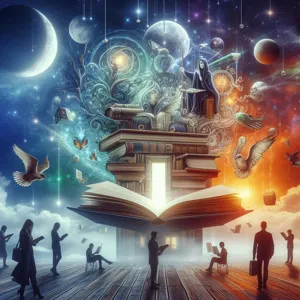
Magical realism is a genre that masterfully intertwines the mundane with the extraordinary, inviting readers into worlds where the improbable becomes possible and the everyday is laced with enchantment. In this realm of literature, the boundaries between reality and fantasy blur, allowing for a unique exploration of human experiences that resonate on multiple levels.
Imagine walking through a bustling market, where a vendor sells not just fruits and spices, but whispers of forgotten dreams and echoes of lost love. A family gathers around the dinner table, engaging in lively conversation, only to have their words materialize into vivid images that dance around the room, illustrating their hopes and fears. These are just glimpses into the transformative power of magical realism, where the extraordinary sits comfortably alongside the ordinary, urging readers to see the world through a different lens.
Books like Gabriel García Márquez’s *One Hundred Years of Solitude* and Isabel Allende’s *The House of the Spirits* showcase this enchanting blend. They weave intricate narratives that are rich with symbolism and deep emotional resonance, all while presenting events that challenge our understanding of reality. The characters often grapple with both the tangible and the ethereal, leading to profound revelations about life, love, and the passage of time.
As you delve into the pages of these works, prepare to be swept away into lush landscapes filled with whimsical occurrences, where the impossible feels achingly familiar. Magical realism not only captivates the imagination but also encourages readers to reflect on their own realities, prompting us to ask: what elements of magic exist in our daily lives? By immersing yourself in these spellbinding tales, you’ll embark on a journey that transcends time and space, leaving you forever changed.
6. Sci-Fi Journeys: Visions of Futuristic Worlds
In the realm of literature, science fiction stands as a beacon of boundless imagination, inviting readers to embark on exhilarating journeys through futuristic landscapes teeming with endless possibilities. These stories often challenge the status quo and push the boundaries of human potential, taking us to worlds where technology and nature intersect in extraordinary ways. With their captivating narratives and thought-provoking themes, sci-fi books not only entertain but also provoke deep reflection about our own existence and the future that lies ahead.
Imagine soaring through the skies in a sleek spaceship, navigating through galaxies filled with alien civilizations, or contemplating the ethical dilemmas of artificial intelligence that has become indistinguishable from humanity. Authors like Isaac Asimov, Philip K. Dick, and Ursula K. Le Guin masterfully craft intricate worlds that allow us to explore themes of identity, society, and the essence of humanity itself.
In these futuristic realms, readers may encounter dystopian societies that serve as cautionary tales, highlighting the potential consequences of unchecked technological advancement and environmental degradation. Conversely, they may also be transported to utopian visions that inspire hope, creativity, and the idea that a better world is possible with innovation and collaboration.
Whether you’re traversing the desolate landscapes of Mars, unraveling the mysteries of time travel, or experiencing the thrill of interstellar conflict, sci-fi journeys offer a unique lens through which to examine our current realities. Buckle up and prepare for liftoff as we delve into ten compelling sci-fi novels that promise to transport you to worlds of wonder, intrigue, and boundless imagination. Each story invites you to not just witness the future but to question, dream, and ultimately, imagine your own place within it.
7. Historical Fiction: Time Travel Through Pages
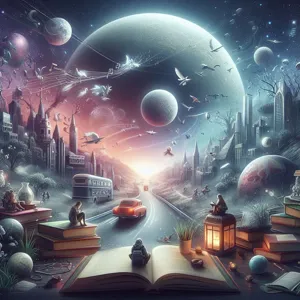
Historical fiction is a captivating genre that serves as a portal to the past, allowing readers to immerse themselves in different eras and experience life through the eyes of characters who lived in those times. These novels not only tell compelling stories but also weave together rich historical details, providing a vivid backdrop that transports you to worlds shaped by events, cultures, and social dynamics long gone.
Imagine walking the cobblestone streets of 19th-century London, feeling the chill of the morning air as you witness the hustle of street vendors and the elegance of horse-drawn carriages. Or perhaps you’re swept away to the tumultuous battlefields of the American Civil War, where the clamor of cannons and the cries of soldiers paint a visceral picture of courage and sacrifice. Each page becomes a time machine, whisking you away to moments that shaped our history and, in many cases, our very identity.
Books like “The Nightingale” by Kristin Hannah offer heart-wrenching narratives set against the backdrop of World War II, illuminating the resilience of the human spirit amidst the horrors of war. Meanwhile, “The Book Thief” by Markus Zusak invites readers into Nazi Germany through the eyes of a young girl, where the power of words becomes a lifeline in dark times. These stories not only entertain but also educate, shedding light on the struggles and triumphs of those who came before us.
In a world where the present often feels overwhelming, historical fiction provides a much-needed escape—a chance to reflect on our past while finding connections to our own lives. As you turn each page, you’ll discover not just the world of historical events, but also the timeless themes of love, loss, and resilience that resonate across generations. So grab a cup of tea, settle into your favorite reading nook, and prepare to be transported through time as you embark on this literary journey through the pages of historical fiction.
8. Contemporary Fiction: Emotional Landscapes and Unique Perspectives
Contemporary fiction often serves as a powerful lens through which we can examine the complexities of modern life, weaving emotional landscapes that resonate with our own experiences. These narratives are rich with diverse voices and unique perspectives that invite readers to step into the shoes of characters navigating the intricacies of love, loss, identity, and societal change.
In this genre, authors skillfully blend realism with the imaginative, crafting stories that feel both relatable and transformative. For instance, novels like *The Night Circus* by Erin Morgenstern transport us into a fantastical realm, where the enchantment of a mysterious circus opens doors to unexpected realities. Meanwhile, works like *Little Fires Everywhere* by Celeste Ng delve into the heart of suburban life, exploring the interplay between privilege and vulnerability through the lives of intertwined families.
Contemporary fiction also often tackles pressing social issues, offering readers a chance to engage with topics such as race, gender, and mental health. Books like *The Hate U Give* by Angie Thomas not only provide a gripping narrative but also challenge readers to confront the harsh realities of systemic injustice.
As you immerse yourself in these stories, you’ll find that contemporary fiction doesn’t just transport you to another world; it compels you to reflect on your own. Each page turned is an opportunity to explore uncharted emotional territories, allowing you to emerge with a broader understanding of both the human experience and your place within it. Whether it’s through the vibrant characters or the intricate plots, contemporary fiction invites you to journey through the depths of imagination and return with insights that linger long after the last page is turned.
9. Young Adult Escapes: Adventures for All Ages
Young adult literature has long been a gateway to fantastical realms and gripping adventures, captivating readers of all ages with its imaginative storytelling and relatable characters. These narratives often blend coming-of-age themes with the thrill of exploration, making them not just for teenagers, but for anyone yearning to escape the mundane and dive into a world where anything is possible.
In “The Hunger Games” by Suzanne Collins, readers are thrust into a dystopian society where survival hinges on cunning and bravery, as protagonist Katniss Everdeen becomes a symbol of rebellion against oppressive forces. The vivid descriptions of the Capitol and the stark contrast of District 12 create a haunting backdrop that pulls readers deep into this gripping saga.
Meanwhile, “Harry Potter and the Sorcerer’s Stone” by J.K. Rowling invites readers to traverse the hallowed halls of Hogwarts School of Witchcraft and Wizardry. Through Harry’s eyes, we experience the wonder of magic, friendship, and the ultimate battle between good and evil. Rowling’s enchanting world, filled with spellbinding creatures and captivating lore, ensures that every turn of the page feels like stepping into another dimension.
For those seeking a more contemporary adventure, “The Fault in Our Stars” by John Green offers a poignant journey through love and loss. It transports readers into the lives of Hazel and Gus as they navigate the realities of living with illness, exploring the depths of human connection and the beauty found in fleeting moments. Though grounded in reality, the emotional depth and relatable struggles offer an escape that resonates deeply with readers of all backgrounds.
These young adult escapes not only entertain but also provoke thought and inspire empathy, making them perfect companions for anyone looking to immerse themselves in new worlds. Whether it’s through fantastical realms, gripping dystopias, or heartfelt explorations of the human experience, these books remind us that adventure and imagination are limitless, waiting to be discovered on every page.
10. Graphic Novels: Visual Journeys Through Imagination
Graphic novels have emerged as a dynamic storytelling medium, blending stunning visuals with compelling narratives to create immersive experiences that can transport readers to fantastical realms and thought-provoking realities. Unlike traditional novels, graphic novels use a combination of artwork and text, allowing for a unique interplay between the two that enhances the emotional depth and engagement of the story.
One of the most captivating aspects of graphic novels is their ability to convey complex themes and ideas through vibrant illustrations. For instance, in *Maus* by Art Spiegelman, the depiction of characters as anthropomorphic animals not only draws readers in but also serves as a powerful metaphor for the human experience during the Holocaust. Similarly, *Sandman* by Neil Gaiman weaves together mythology, history, and dreamscapes, inviting readers to explore a universe where dreams shape reality.
The visual nature of graphic novels creates a multifaceted reading experience, allowing for immediate emotional connections through facial expressions and dynamic action sequences. Titles like *Saga* by Brian K. Vaughan and Fiona Staples plunge readers into an epic space opera filled with intergalactic conflict and love, while *Persepolis* by Marjane Satrapi offers a poignant memoir of growing up during the Iranian Revolution, combining stark black-and-white illustrations with personal narrative to evoke empathy and understanding.
Moreover, graphic novels cater to a variety of tastes and genres, from fantasy and science fiction to memoir and historical fiction, making them accessible to a wide audience. Whether it’s the whimsical adventures in *Bone* by Jeff Smith or the gripping dystopian tale of *Y: The Last Man*, there’s a graphic novel for every reader seeking to escape reality.
In a world where imagination knows no bounds, graphic novels stand as a testament to the power of storytelling, inviting readers to embark on visual journeys that ignite the imagination and resonate long after the final page is turned. So, pick up a graphic novel, let the artwork wash over you, and prepare to be transported to worlds beyond your wildest dreams.
11. The Role of Setting in Creating Immersive Experiences
The setting in a story serves as more than just a backdrop; it plays a pivotal role in crafting immersive experiences that transport readers to another world. A well-developed setting can evoke emotions, create tension, and even influence character development, making it a crucial element in a narrative. From the bustling streets of a dystopian city to the serene landscapes of a magical realm, the environment in which the story unfolds shapes the reader’s imagination and emotional journey.
Consider J.R.R. Tolkien’s Middle-earth in “The Lord of the Rings.” The richly detailed landscapes—ranging from the peaceful Shire to the foreboding depths of Mordor—invite readers to explore the complexities of this universe. The intricacies of the geography, culture, and history encapsulated within each location allow readers to become fully immersed, as if they are walking alongside Frodo and Sam on their perilous quest.
Similarly, in “The Night Circus” by Erin Morgenstern, the setting of the mysterious circus itself acts as a character, enchanting readers with its vivid imagery and whimsical atmosphere. Every tent and attraction is imbued with magic, drawing readers into a world where time and reality bend in fantastical ways.
Effective settings do not just serve to enhance the plot; they breathe life into the story. They can elicit a sense of nostalgia, provoke curiosity, or even instill fear. The sights, sounds, and smells described create a sensory experience that pulls readers deeper into the narrative. A well-constructed setting allows readers to escape the confines of their own lives and lose themselves in the pages of a book, experiencing adventures and emotions that stretch far beyond their everyday reality.
In your literary quest, pay attention to how settings are crafted. Consider how they impact the characters’ journeys and how they resonate with your own experiences. Engaging with these worlds not only broadens your imagination but also deepens your understanding of storytelling itself. So, as you explore the ten books on this list, let the settings guide you into realms of wonder and excitement, where every word is a stepping stone to a new adventure.
12. Tips for Enhancing Your Reading Experience
Reading is not just about the words on the page; it’s an immersive experience that can transport you to fantastical realms or evoke deep emotions. To fully embrace the magic of your literary journey, consider these tips for enhancing your reading experience.
First, create a dedicated reading space that invites you to escape. This could be a cozy nook adorned with soft cushions, a warm blanket, and a good reading lamp. The right ambiance can set the tone for your adventure, making it easier to lose yourself in the narrative. Dim lighting, perhaps paired with a calming scent from a candle or essential oil, can heighten your senses and draw you deeper into the story.
Next, consider pairing your reading with a warm beverage. A cup of tea, coffee, or hot chocolate can create a comforting ritual that enhances your enjoyment. As you sip, take a moment to savor the rich flavors, allowing them to become part of the sensory experience of reading.
Minimize distractions to fully immerse yourself in the world of the book. Turn off notifications on your devices, or better yet, leave your phone in another room. This will help you focus on the characters and plot, allowing their journeys to resonate with you without interruptions from the outside world.
Additionally, consider keeping a journal or a reading log. Jotting down your thoughts, favorite quotes, or reflections on the story can deepen your engagement. It’s also a wonderful way to track your journey through different worlds and revisit the moments that moved you.
Lastly, don’t hesitate to discuss the books you read with friends or join a book club. Engaging in conversations about the themes, characters, and settings can open new perspectives and enhance your understanding of the story. Sharing your thoughts with others can also create a sense of community, making your reading experience even more enriching.
By incorporating these tips into your reading routine, you can elevate your literary adventures and allow each book to transport you to another world in ways you never imagined. Happy reading!
13. Personal Reflections: How These Books Changed My Perspective
Reading has an unparalleled ability to shift our perspective, and the books on this list have profoundly impacted my understanding of the world and my place within it. Each story is a portal, transporting me to different realms, cultures, and experiences that challenged my preconceived notions and broadened my horizons.
Take, for example, *The Alchemist* by Paulo Coelho. This enchanting tale of a shepherd’s journey in search of his “Personal Legend” ignited a spark within me to pursue my own dreams relentlessly. It taught me that the universe conspires to help those who chase their passions, a lesson that reverberates in my daily choices and inspires me to embrace the unknown.
Similarly, reading *The Night Circus* by Erin Morgenstern was like stepping into a dreamscape where magic and reality intertwine. The intricate narrative and vivid imagery reminded me of the beauty of imagination and creativity. It encouraged me to find wonder in the mundane and appreciate the artistry in everyday life.
Then there’s *Sapiens: A Brief History of Humankind* by Yuval Noah Harari, which offered a stark yet fascinating look at the evolution of our species. This book reshaped my understanding of history and humanity’s interconnectedness, prompting deep reflections on our societal structures and collective future.
Each of these works has not only entertained me but has also been a catalyst for personal growth and reflection. They have urged me to question, to dream, and to see the world through a more empathetic lens. In a time where division seems rampant, these stories have taught me the power of connection, reminding me that, at our core, we share similar hopes, struggles, and dreams. As you embark on your own journey through these pages, I hope you, too, find shifts in your perspective that inspire and transform you.
14. Conclusion: The Lasting Impact of Transportive Literature
As we draw the curtains on our exploration of the ten transformative works that whisk readers away to fantastical realms, it’s essential to reflect on the profound impact of transportive literature. These books do more than merely provide a temporary escape; they invite us to engage with different cultures, perspectives, and experiences that broaden our understanding of the world around us.
When we dive into the pages of a gripping fantasy or a thought-provoking sci-fi novel, we are not just passive observers but active participants in intricate narratives that challenge our imagination and emotions. Each story serves as a portal, allowing us to traverse time and space, meet extraordinary characters, and confront the complexities of life in ways we may never encounter in our daily routines.
Moreover, the themes we uncover within these narratives resonate deeply, often shining a light on our own lives and prompting introspection. Whether it’s the quest for identity in a dystopian future or the exploration of love across galaxies, these books encourage us to reflect on our values and aspirations, transforming us long after the final page is turned.
In a world that can sometimes feel overwhelming, transportive literature offers solace and inspiration. It reminds us of the power of storytelling to ignite our imaginations and foster empathy. So, the next time you seek to escape, remember that within the pages of a well-crafted book lies not just an adventure but a chance to discover new facets of yourself and the human experience. Embrace the journey, and allow your imagination to soar as you delve into the worlds waiting to be explored.
15. Call to Action: Share Your Favorite Books That Transport You!
As we wrap up our literary journey through the pages of captivating worlds, we invite you to join the conversation and share your own favorites! What books have whisked you away to distant lands, enchanted realms, or thrilling adventures? Perhaps it was a classic that opened your eyes to new perspectives, or a contemporary gem that left you breathless with its imaginative storytelling.
We’d love to hear about the stories that have sparked your imagination, made you laugh, or even brought a tear to your eye. Whether it’s a fantasy saga filled with mythical creatures, a historical novel that painted vivid images of bygone eras, or a sci-fi thriller that took you to the far reaches of the galaxy, your recommendations can inspire fellow readers to embark on their own adventures.
Drop your suggestions in the comments below, and let’s create a treasure trove of literary escapes for everyone seeking their next great read. Reading is not just about the journey taken through the pages; it’s also about the community built around sharing those experiences. So, what are you waiting for? Share the titles that have transported you to another world! Your next favorite book could be just a comment away!
As we conclude our exploration of the ten enchanting books that can whisk you away to other worlds, we hope you feel inspired to embark on your next literary adventure. Each of these titles offers a unique portal to realms filled with wonder, imagination, and unforgettable characters, inviting you to escape the everyday and immerse yourself in captivating narratives. Whether you’re seeking the thrill of a fantastical quest, the warmth of a heartfelt journey, or the intrigue of a mysterious universe, these stories promise to ignite your imagination and broaden your horizons. So, grab your favorite reading nook, a cozy blanket, and dive into these literary treasures—your next great adventure is just a page away! Happy reading!

